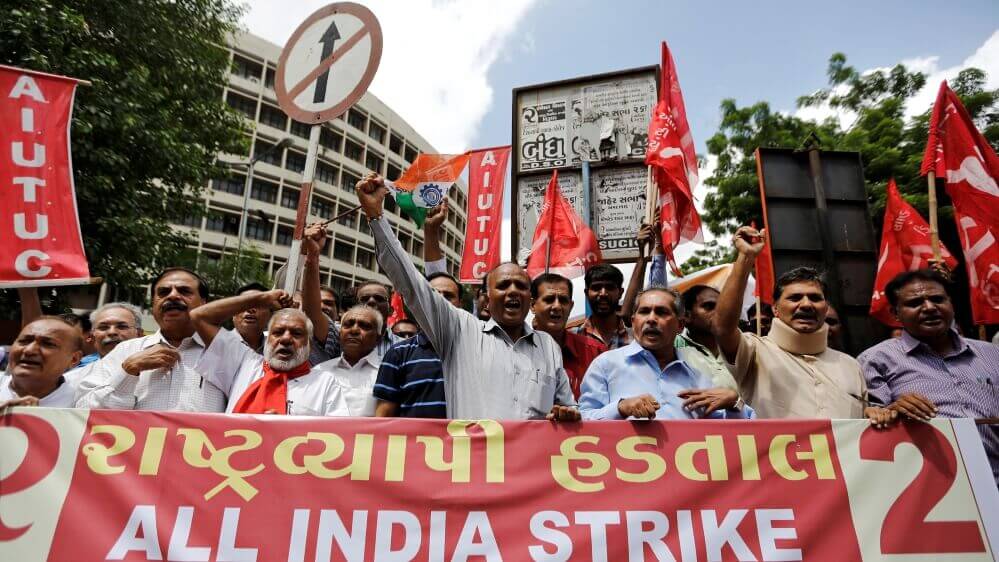The trade union movement in India can be distinctively studied through three phases (Sahoo, 1999). The first phase covered the period from 1875 to the end of World War I. This phase was mainly characterized by a humanitarian spirit that was employed by the friendly societies in dealing with the labour. The second phase began from the end of World War I and went on till 1947, the year of India’s independence. This phase was quite remarkable as it saw the beginning of real modern trade unionism in India with organized and continuous labour movement.
The earliest trade union was formed in Bombay when textile mills were established in 1851. Trade unions also emerged in Calcutta in 1854 with the establishment of jute mills there. Shorabji Shapuri Bengali and C.P. Mazumdar were among the pioneers of these early labour uprisings in the country.
The first factory Commission was set up in 1879 to study the problems of workers. In 1891, the first factory act- The Indian factory Act was passed but it remained ineffective. The Second Factory Commission was formed in 1884 to which a memorandum signed by Narayan Meghji Lokhande along with 5300 workers was submitted. Thus Lokhande emerged as the first trade union leader of India. In the year 1890, Lokhande arranged a mass rally of 10,000 workers, where two women workers demanded Sunday as weekly off. Simultaneously, the first memorandum was submitted to Mill Owners’ Association who accepted the demand. This event was recognized as the first trade union victory in the country. This trade union rally led to the formation of the first trade union called ‘Bombay Millhands Association’. However, the union had no funds, office bearers and committee members.
This was followed by the formation of other trade unions across the country and organized strikes started taking place. Trade unions like Ahmedabad Weavers (1895), Jute Mills, Calcutta (1896), Bombay Mill workers (1897) and the Social League (1910) were formed. Some of the notable strikes that took place around this time were by the Madras Press Workers (1903), Printers Union, Calcutta (1905) and the Bombay Postal Union (1907). The strike of the Madras Textile Workers (The 1921 Buckingham and Carnatic Mills Strike was a strike by the workers of Buckingham and Carnatic Mills in the city of Madras that is now called Chennai) was remarkable. As, V. Kalyanasundaram Mudaliar, the leader of the strike puts it
“… There have been many lock-outs and strikes in the world. It is said that the Gret Steel Sorkers’ strike in America was the biggest of them. The lock-out and the strike of Madras Textile Workers (1921) stand on par with that…”
Thus, the trade union movement began to gather momentum in the country. The Madras Labour Union was formed in 1918 with B.P. Wadia as the president. Wadia, an ex-member of the Indian Home Rule League, was the president of five trade unions in Madras. One of the foremost influential trade union leaders in India, he said that the economic aim of the Indian Labour movement is not only to get higher wages and other benefits but to completely eradicate wage slavery. Despite the absence of legal protection and facing bullets and intimidation threats from the employers, the union achieved dignity and improved conditions.
Another important figure in the trade union movement in India was N.M. Joshi. In 1921, Joshi was quite influential in persuading the Government of India to accept the resolution moved by him in 1921 in the Central Legislative Assembly requesting for the legislation for the registration and protection of trade unions. It was after 5 years that the Trade Unions Act of 1926 was enacted. There was a rise in the membership of trade unions during this time which but declined during the Great Depression of 1930. In 1934, the number of trade unions in India was 191.
The International Labour Organization (ILO) was formed soon after the first World War in 1919. The formation of ILO was instrumental in inspiring the leaders of India towards the formation of All India Trade Union Congress (AITUC), the first national-level trade union in India in 1920. Lala Lajpat Rai was elected as its first president who later also attended the ILO Conference in Geneva in 1926. Other national-level trade unions were also formed subsequently. The most notable among these were Indian National Trade Unions Congress (INTUC) in 1947, the Hind Mazdoor Sabha (HMS) in 1948 and the Centre of Indian Trade Unions (CITU) in 1970.
Trade Unions in India have grown since then. As per data obtained from the Labour Bureau, the total number of registered trade unions across the country numbered to 11556 in 2013 and the average membership per union was 1283. Amidst the well-known fact that the degree of unionism is not very high in India, the concentration of union membership is high in critical sectors like banking, insurance, railways, postal services, ports, telecoms and power (Sundar, 2008). In addition, in recent decades, the stronghold of the political unions has been challenged by the growth of enterprise unions. The prevalence of the Liberalization, Privatisation and Globalisation (LPG) model in India since 1991, along with the various labour flexibility measures adopted by employers, and the decline in jobs in the organized sector are creating challenges to unions, which are also simultaneously, providing opportunities to restructure the union movement.

SOURCE: EASTERN EYE
